Arte & Cultura
Il Guerriero di Capestrano: enigma d’Abruzzo- The Capestrano Warrior: An Abruzzo Enigma
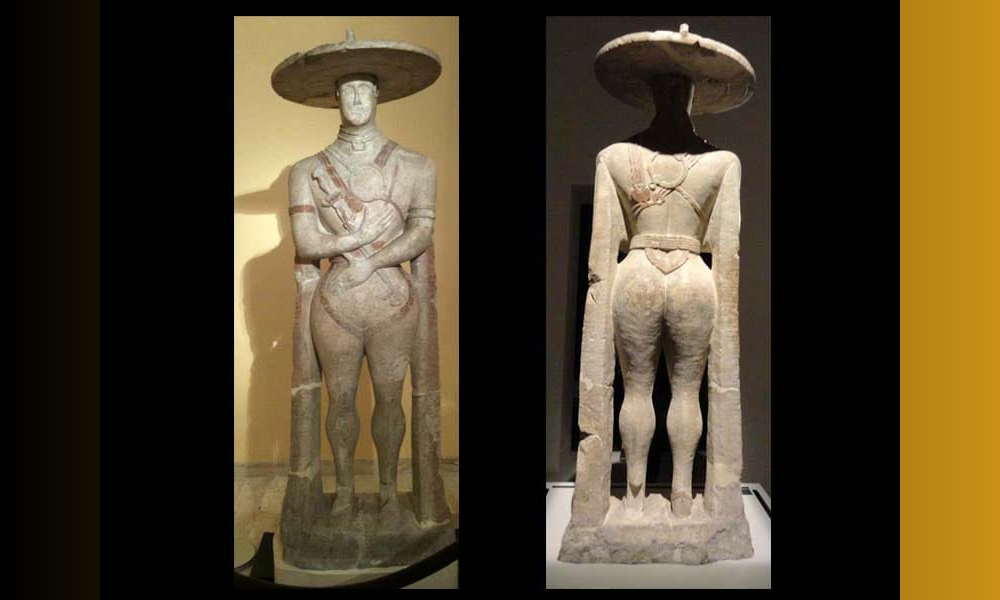
Il Guerriero di Capestrano: enigma d’Abruzzo
di Laura Marà
Avvolto da un’aura di mistero che sfida il tempo, in Abruzzo, in provincia dell’Aquila si erge un’opera d’arte enigmatica: il Guerriero di Capestrano. Ritrovato per puro caso nel 1934, questa scultura monumentale in pietra calcarea rappresenta una delle testimonianze più straordinarie e meglio conservate dell’arte italica, un ponte diretto con l’antica e sfuggente civiltà dei Piceni. La sua storia e i suoi dettagli continuano a interrogare studiosi e appassionati, rendendola un vero e proprio simbolo dell’Abruzzo “forte e gentile”.
Un Ritrovamento Fortuito e una Rivelazione Storica
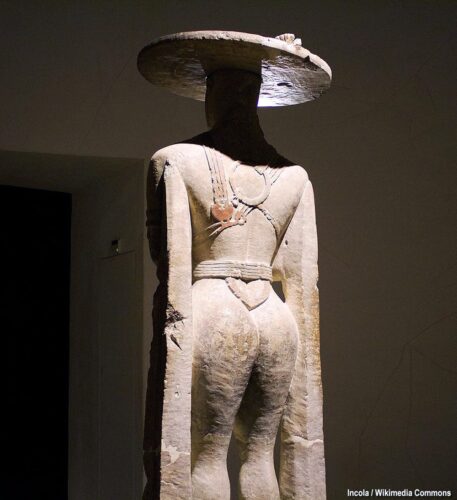
La genesi di questa icona è degna di un romanzo. Siamo nel 1934 e un contadino abruzzese, Michele Castagna, sta dissodando il suo campo in località “Cinericcio”. Invece di trovare radici o sassi, la sua vanga s’imbatte in un blocco di pietra che, una volta emerso dalla terra, rivelerà il volto severo e stilizzato di un guerriero. Nessuno, in quel momento, poteva immaginare che da quel terreno sarebbe affiorata una delle opere più significative della storia italiana, risalente al VI secolo a.C.
Accanto alla statua imponente, alta ben 2 metri e 10 centimetri, fu rinvenuto anche un busto di donna, subito ribattezzato la “Dama di Capestrano”. Gli studiosi ipotizzano che la Dama possa rappresentare la moglie o la figlia del guerriero, a sottolineare il contesto funerario del ritrovamento, che avvenne in quella che fu la necropoli dell’antica città di Aufinum.
Il Re Guerriero e la Firma Misteriosa
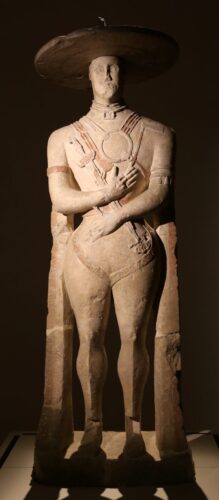
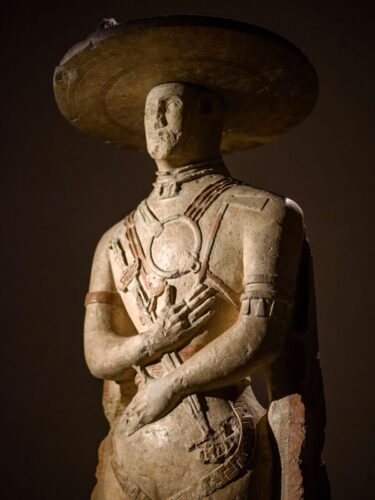
La scultura raffigura un guerriero dell’antico popolo dei Piceni, che si stanziò tra gli Appennini e l’Adriatico. Ciò che eleva il Guerriero da semplice reperto a capolavoro è la sua monumentalità e lo straordinario stato di conservazione. La figura è imponente, con spalle che raggiungono l’ampiezza inusuale di 135 centimetri, ed è protetta da un’armatura ricca di dettagli, dai kariophylakes (paracuore) sul torace ai calzari sulle caviglie.
Ma chi era l’uomo raffigurato? Il mistero si schiude grazie a un’iscrizione incisa su una delle colonnine laterali che sorreggono la statua. Il testo, in una lingua di tipo osco-umbro arcaico o sud-picena, ha generato in passato accesi dibattiti, ma l’interpretazione più accreditata recita: “me bella immagine fece Aninis per il Re Nevio Pompuledio”. Questo versetto non solo svela l’identità del guerriero, il Re Nevio Pompuledio, ma fornisce anche il nome dell’artista, Aninis. Questo fatto è di per sé eccezionale: la statua è dunque un’effige tombale realizzata per un regnante illustre, concepita per trasmettere forza, vigore e solennità più che per essere un ritratto fedele.
Enigmi e Suggestioni Stilistiche
Il Guerriero di Capestrano è un vero e proprio puzzle di scelte stilistiche uniche. La sua datazione, successiva a quella di altri reperti coevi, e l’eccezionale cura dei dettagli suggeriscono un’opera all’avanguardia per l’epoca. Alcuni studiosi vedono nella posizione delle braccia, incrociate sul petto e sul ventre in un gesto ritualistico, la prima significativa traccia dell’influenza artistica etrusca sulle popolazioni adriatiche, un ponte tra culture. È interessante notare come l’ascia che il guerriero tiene nella mano destra non sia solo un’arma, ma sia stata interpretata anche come un’ascia da sacrificio, indicando forse il ruolo del re come mediatore tra gli uomini e la divinità.
Tuttavia, gli elementi più intriganti sono i suoi misteriosi accessori e le sue fattezze:
- Il Copricapo Discoidale: La testa è sormontata da un bizzarro copricapo a disco, ampio e peculiare, che ricorda vagamente un sombrero. Non esistono altre testimonianze di elmi di questo tipo nell’arte picena, portando a diverse teorie: potrebbe essere stato uno scudo riutilizzato per praticità o un semplice elmo da parata cerimoniale.
- Il Volto Mascherato: I lineamenti del viso sono esagerati e privi di verosimiglianza. Questa stilizzazione estrema suggerisce agli storici che non si tratti del ritratto di un volto, ma piuttosto di una maschera funeraria, pensata per celare l’identità e proteggere l’individuo nel passaggio nell’oltretomba.
- L’Androgino Guerriero: Forse il dettaglio più sconcertante è l’aspetto vagamente androgino del corpo. Con la vita stretta, i fianchi larghi, il fondoschiena rotondo e le mani affusolate, la figura presenta tratti associati alla fisicità femminile. Gli esperti, però, non considerano questa scelta casuale o ingenua. Si ritiene che l’ambiguità sessuale fosse una deliberata scelta stilistica per estremizzare la potenza simbolica dell’opera, celebrando il guerriero e l’intera popolazione picena (uomini e donne) attraverso una figurazione mitica e fantastica dell’idea di Re guerriero.
Un Simbolo Attuale
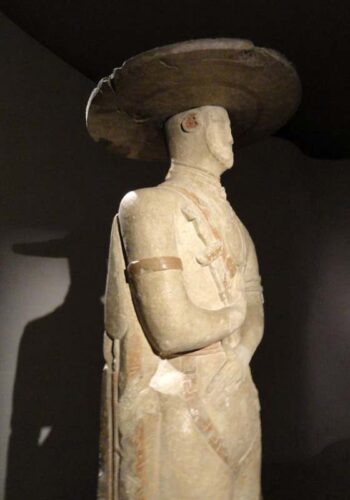
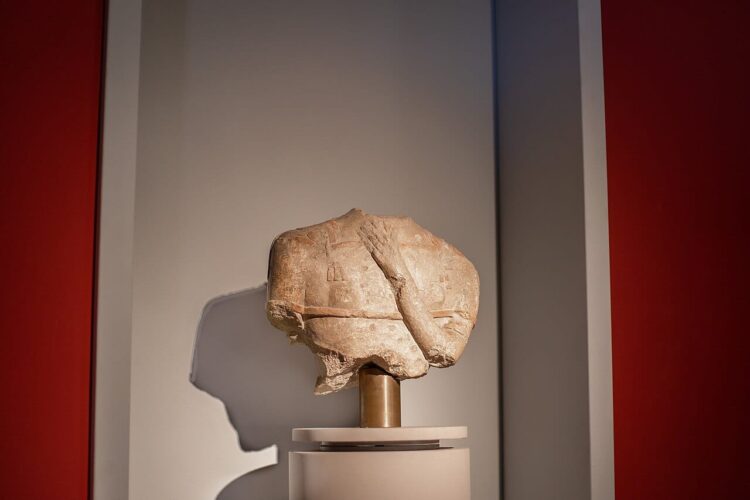
Nonostante sia stato rinvenuto a Capestrano, l’originale Guerriero di Capestrano è oggi conservato in un luogo che ne esalta la monumentalità e il valore: il Museo Archeologico Nazionale d’Abruzzo, ospitato nella splendida Villa Frigerij a Chieti. Una riproduzione a grandezza naturale si trova invece nel Castello Piccolomini di Capestrano, a ricordare il luogo della sua miracolosa emersione.
Dopo nove decenni dal suo ritrovamento, il Guerriero continua a essere un catalizzatore di studi e dibattiti, un monumento che, pur svelando il nome del suo regnante, tiene ancora celati i segreti più profondi dell’arte e della mentalità di un popolo antico. È una statua-stele che non solo ha resistito al tempo, ma che è diventata il potente ed enigmatico simbolo dell’identità regionale abruzzese.
Cosa ti affascina di più di questo misterioso Re guerriero e della sua storia?
The Capestrano Warrior: An Abruzzo Enigma
by Laura Marà
Enshrouded in an aura of timeless mystery, a colossal and enigmatic work of art stands in Abruzzo, in the Province of L’Aquila: the Capestrano Warrior (Guerriero di Capestrano). Accidentally discovered in 1934, this monumental limestone sculpture represents one of the most extraordinary and best-preserved testimonies of Italic art, forming a direct link to the ancient and elusive Piceni civilization. Its history and intricate details continue to intrigue scholars and enthusiasts alike, establishing it as a true symbol of the Abruzzo region—known for its “strong and gentle” character.
A Fortuitous Find and a Historical Revelation


The genesis of this iconic artifact is worthy of a historical novel. In 1934, an Abruzzese farmer, Michele Castagna, was tilling his field in the locality known as “Cinericcio.” Instead of roots or stones, his plow struck a massive block of stone which, once unearthed, revealed the severe and stylized face of a warrior. No one at that moment could have conceived that this field would yield one of the most significant works in Italian history, dating back to the 6th century BCE.
Adjacent to the imposing statue, which stands 2.10 meters (6 ft 11 in) tall, a bust of a woman was also found, immediately dubbed the “Lady of Capestrano” (Dama di Capestrano). Scholars hypothesize that the Lady may represent the warrior’s wife or daughter, emphasizing the funerary context of the find, which took place in what was the necropolis of the ancient city of Aufinum.
The Warrior King and the Mysterious Signature


The sculpture depicts a warrior belonging to the ancient Piceni people, who settled between the Apennine Mountains and the Adriatic Sea. What elevates the Warrior from a mere artifact to a masterpiece is its sheer monumentality and its extraordinary state of preservation. The figure is dominating, with shoulders that reach an unusual width of 135 centimeters (4 ft 5 in), and is protected by rich armor details, from the kariophylakes (heart-protectors) on the chest to the greaves on the shins.
But who was the man depicted? The mystery begins to unfold thanks to an inscription etched onto one of the lateral columns supporting the statue. The text, in an archaic Oscan-Umbrian or South Picene language, has generated intense debate, but the most widely accepted interpretation reads: “me bella immagine fece Aninis per il Re Nevio Pompuledio” (The beautiful image Aninis made for King Nevio Pompuledio). This verse not only reveals the warrior’s identity, King Nevio Pompuledio, but also provides the name of the artist, Aninis. This fact is exceptional: the statue is thus a tomb effigy created for an illustrious ruler, conceived to convey strength, vigor, and solemnity rather than a faithful physical portrait.
Enigmas and Stylistic Suggestions
The Capestrano Warrior is a complex puzzle of unique stylistic choices. Its date, later than that of other contemporary finds, and its exceptional attention to detail suggest it was an avant-garde work for its time. Some scholars interpret the position of the arms, crossed over the chest and stomach in a ritualistic gesture, as the earliest significant trace of Etruscan artistic influence on the Adriatic populations, creating a bridge between cultures. It is noteworthy that the axe the warrior holds in his right hand may not only be a weapon but has also been interpreted as a sacrificial axe, perhaps signifying the king’s role as a mediator between humanity and the divine.
However, the most intriguing elements remain his mysterious accessories and physical features:
- The Discoidal Headdress: The head is crowned by a bizarre, broad disk-shaped headdress that vaguely resembles a sombrero. No other similar helmets are attested in Picene art, leading to several theories: it may have been a shield repurposed for practicality or a simple ceremonial parade helmet.
- The Masked Face: The facial features are exaggerated and lack verisimilitude. This extreme stylization suggests to historians that it is not a portrait of a face, but rather a funerary mask, intended to conceal identity and protect the individual during the passage to the afterlife.
- The Androgynous Warrior: Perhaps the most disconcerting detail is the body’s vaguely androgynous appearance. With a narrow waist, wide hips, a rounded posterior, and slender, delicate hands, the figure displays traits typically associated with the female physique. Experts, however, do not view this as a casual or naive choice. It is believed that the sexual ambiguity was a deliberate stylistic decision intended to heighten the symbolic power of the work, celebrating the warrior and the entire Piceni populace (men and women) through a mythic and fantastical representation of the ideal Warrior King.
An Enduring Symbol
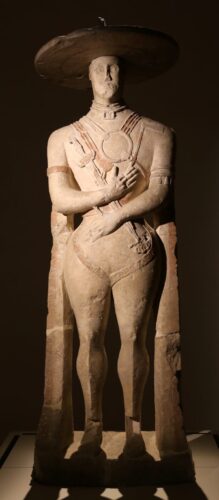

Although unearthed in Capestrano, the original Capestrano Warrior is currently preserved in a location that emphasizes its monumental importance and value: the National Archaeological Museum of Abruzzo (Museo Archeologico Nazionale d’Abruzzo), housed in the splendid Villa Frigerij in Chieti. A life-size reproduction is displayed in the Piccolomini Castle of Capestrano, commemorating the site of its miraculous discovery.
Nine decades after its emergence, the Warrior continues to be a catalyst for studies and debates. A monument that, while revealing the name of its ruler, still holds the deepest secrets of an ancient people’s art and mentality. It is a statue-stele that has not only withstood the passage of time but has become the powerful and enigmatic symbol of Abruzzo’s regional identity.


















